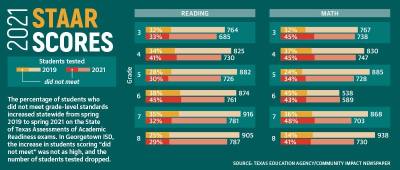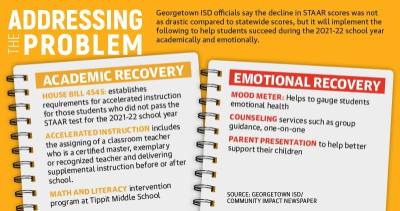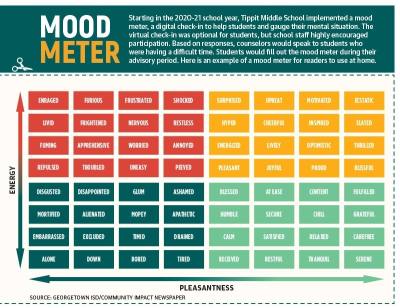Districtwide, GISD saw a 5.53 percentage point increase in the number of students who did not meet state expectations from 2019 to 2021 on the State of Texas Assessments of Academic Readiness, according to state data, which was lower than neighboring districts such as Hutto and Leander ISDs.
Apart from STAAR, the district also conducts the Measuring Academic Progress, or MAP, assessment, that showed “strong evidence of growth in reading and math,” according to the district.
District officials attribute this growth to the work of its teachers, Vanicek said.
“I think we were pleasantly surprised, and hopeful, based on the energy and efforts of our teachers,” Vanicek said. “Our [teachers] did a lot of really great work this [past] year, despite horrible circumstances.”
Learning loss at GISD
Students in Texas typically experience a 2.5-month learning loss returning to school each fall, which is considered normal. However, this gap has increased to 5.7 months as a result of the COVID-19 virus and the changes districts were forced to make, according to the Texas Education Agency.
In June, the state released the 2021 STAAR data that showed GISD students fell behind their 2019 scores and that students scored below the state average in several grades and subjects.
According to the data, the percentage of students in third through eighth grade who approached grade-level STAAR scoring dropped off across nearly every testing subject area between 2019 and 2021. The 2021 scores ranged from a 1 percentage point dip in third grade reading to a 13 percentage point decline in third grade math.
“Statewide everybody [declined],” Vanicek said. “[GISD] saw a similar trend. The difference that we saw though was our fall-off was less dramatic [compared to the state’s].”
While the district did see an increase in the percentage of students who did not meet state expectations, STAAR data showed the increases were less than those at other districts or compared to state averages. The district saw a 3.02 percentage point increase and a 2.68 percentage point increase in reading and math, respectively, according to TEA data.
STAAR achievement did increase slightly year over year for three exam sections—seventh grade reading, seventh grade writing and sixth grade math—and the district equaled the state-level marks in seventh grade reading and seventh grade writing.
GISD students did not outpace STAAR statewide averages for approaching grade-level standards in any grade or subject area. However, GISD officials said they look more at MAP scores for student performance.
“MAP testing scores help us determine where [students] are in their growth throughout the year,” said Rachael Robertson, Tippit Middle School English language arts department head.
From the classroom
For Tippit Middle School Principal Alfonso Longoria, what helped students thrive during the 2020-21 school year was the effort teachers put into helping their students succeed despite the circumstances.
“I think a big part of student growth in GISD and here at Tippit is because of the [teachers’] relationships with students,” Longoria said. “Our teachers worked really hard at helping kids feel safe and saying that we’re going to get through this.”
Robertson made sure that she and her students were in constant communication, offering any help that was needed. Using Google Meet video conferencing, emailing, tutoring and even being available during the weekends became key to helping students succeed, Robertson said.
Teachers offered different kinds of opportunities to help students; some would even go as far as offering tutoring for subjects different than the one they taught, she said.
“I think that the No. 1 reason we saw so much growth is the relationship aspect [between] teachers and students,” Robertson said.
Robertson said for most students, learning was during in-person learning, adding that students wanted to have discussions with their peers and one-on-one time with their teachers.
To help with the human interaction that is needed with learning, Tippit implemented a mood meter or a digital check-in to try and help students and gauge their mental situation, Longoria said.
Approximately 75% of the time students expressed a positive emotion about school; 15% of the time students expressed they were tired; and 10% of the time students had a negative emotion about school, Longoria said.
“It was powerful because our counselors would know [the students’ emotional level] right away in the morning and know [that] we got to talk to these kids,” Longoria said. “That helps the teacher because there’s another layer of support to help them with their students.”
GISD Director of Counseling Services David Rainey said it is important for teachers to be aware of where students are emotionally so teachers can provide them with the tools necessary to succeed.
The transition to virtual learning did affect some students more than it did others, said Terri Conrad, GISD chief strategist for learning design. At the elementary level, most students said they wanted to return to in-person learning, while at the higher grades students preferred virtual learning, she said.
Working to make up for time that was lost, GISD started its JumpStart summer learning program for students in first through eighth grade, Conrad said. The new program is focused on accelerated learning to help students catch up, acclimate to being around kids again and using critical thinking skills, she said.
“[JumpStart] is really about if we can get kids geared up about learning again,” Conrad said.
Moving forward
GISD will also comply with House Bill 4545, which requires adding accelerated instruction for students who did not pass the STAAR test for the 2021-22 school year, according to the TEA.
Accelerated instruction includes assigning a classroom teacher who has earned a TEA certification and delivering additional instruction before or after school.
Tippit Middle will also implement a math and literacy intervention program. This involves personalized instruction, extra time for learning, and offering academic recovery camps on Saturdays for reading and math, Longoria said. Students will be invited to participate based on student data.
GISD officials will also emphasize the availability of counseling services to ensure teachers are aware of the different emotional places students will be at this year, Rainey said. Counselors provide guidance in large groups as well as one-on-one support if students need it, he added.
Tippit Middle plans to continue using the mood meter, Longoria said.
“At this point in the pandemic, we are looking at [learning] a little bit differently than, ‘Oh you’re coming to us with this loss; we need to try to fill you in,’” Vanicek said. “It is more like, ‘Let’s see where you are and pick up and keep moving forward.’”
Ben Thompson contributed to this report.









